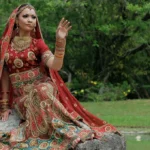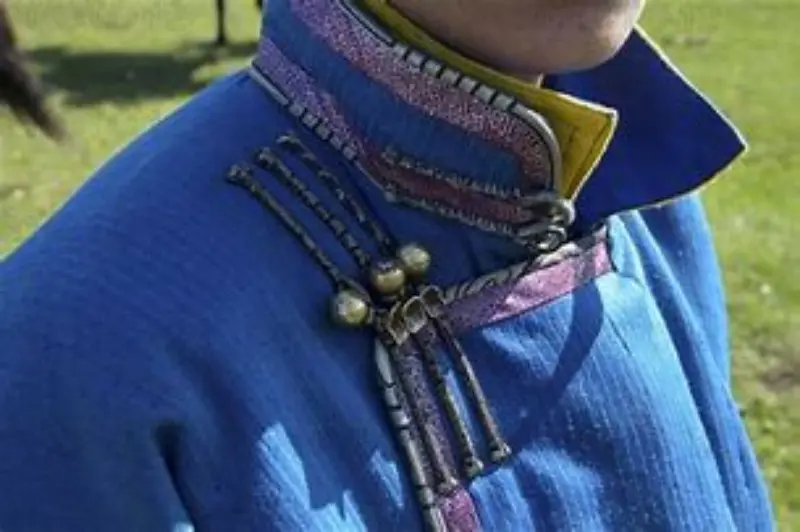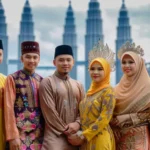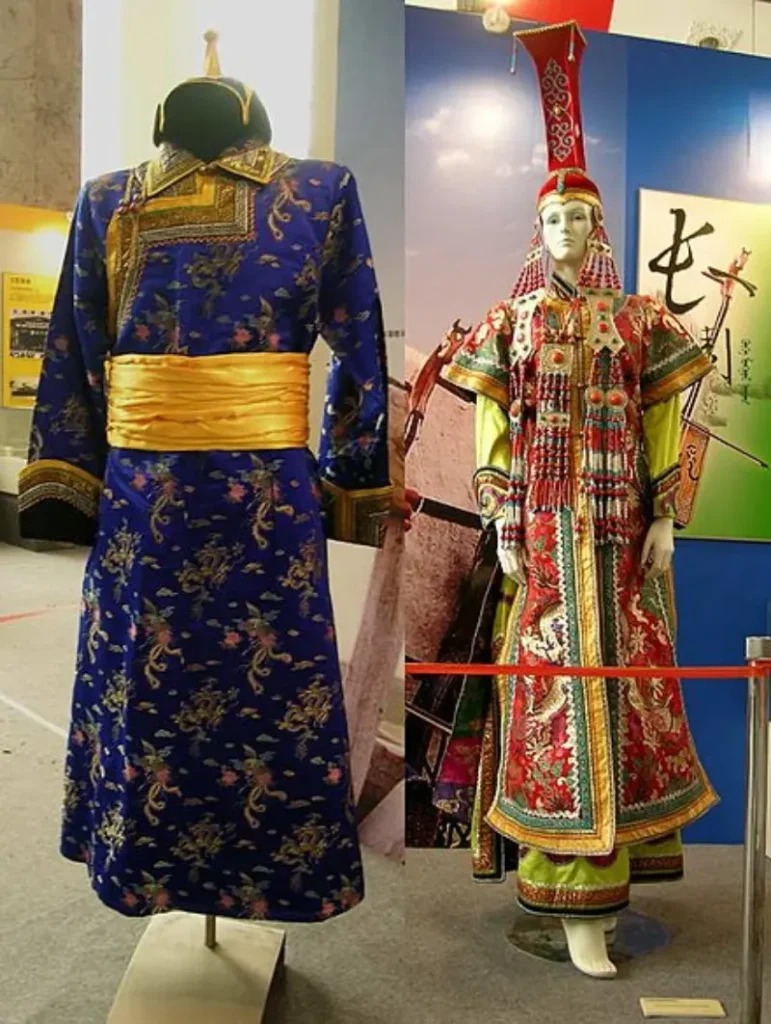The Origins of the Mongolian Deel
The Mongolian Deel is a centuries-old traditional garment that has evolved alongside Mongolia’s rich history and culture. Originating during the time of the Mongol Empire, the deel was designed for both practicality and symbolism, reflecting the nomadic lifestyle of the Mongols.

Historical Significance
The deel traces back to the 13th century, during the height of the Mongol Empire. It symbolized unity among tribes while adapting to the harsh climatic conditions of the steppe. With its long, flowing design, it allowed easy movement for riders and warmth during extreme winters.
Cultural Identity
More than clothing, the deel represents Mongolia’s cultural heritage. Worn during celebrations, festivals, and daily life, the colors, patterns, and materials used signify different tribes, social statuses, and even regions.
Functional Design
The deel’s wraparound design makes it ideal for Mongolia’s variable climate. With adjustable folds and a tied sash, it provides both flexibility and insulation, demonstrating an ingenious adaptation to the environment.
See also A Cultural Tapestry: The Timeless Elegance of Malaysia’s Baju Kurung
A Cultural Tapestry: The Timeless Elegance of Malaysia’s Baju Kurung
The Structure and Design of the Mongolian Deel
The deel is a deceptively simple garment with intricate features that make it versatile and aesthetically pleasing. Its design emphasizes functionality, modesty, and beauty.

Main Components
A deel typically includes:
- Outer Garment: A long, loose robe with wide sleeves.
- Sash (Belt): A piece of fabric used to secure the deel and provide structure.
- Collar and Buttons: Often adorned with traditional patterns and crafted for durability.
Materials Used
Traditionally, deels are made of materials like silk, cotton, or wool, depending on the season and the wearer’s status. The winter deel, for instance, is padded and lined with fur for insulation.
Variety of Styles
Mongolia’s diverse regions bring unique deel styles. For instance:
See also Traditional Malaysian Attire: Exploring the Elegance of Baju Melayu
Traditional Malaysian Attire: Exploring the Elegance of Baju Melayu
- Khalkha Mongols prefer elegant, brightly colored deels.
- Kazakh Mongols incorporate embroidery and metallic threads for a regal look.
Colors and Patterns: What They Represent
Every aspect of the deel is symbolic, particularly its colors and patterns, which convey social, spiritual, and regional significance.

Regional Variations
- Eastern Mongolia: Bright reds and blues dominate, reflecting the energy of the sun and sky.
- Western Mongolia: Earth tones and geometric patterns signify connection to the land.
Symbolism in Colors
- Red: Strength and power.
- Blue: Eternity and the vast Mongolian sky.
- Gold and Silver: Prosperity and status.
Patterns with Meaning
Traditional patterns often incorporate motifs like clouds, animals, or mythological symbols. These designs are deeply rooted in Mongolian folklore and shamanistic beliefs.
Crafting a Deel: The Art of Mongolian Tailoring
Creating a deel is a meticulous process that combines ancient techniques with artistic skill.

Selection of Fabric
Artisans carefully choose fabrics that suit the wearer’s needs and the purpose of the garment. For example:
- Lightweight silk for festive deels.
- Thick wool for winter garments.
Traditional Techniques
Hand-stitching and embroidery are common in deel-making, with emphasis on durability and aesthetic appeal. Patterns are often drawn freehand, showcasing the tailor’s expertise.
Modern Adaptations
Today, deel production incorporates modern tools, but many tailors preserve the traditional methods passed down through generations.
The Deel as Everyday Wear
Though rooted in tradition, the deel remains an integral part of daily life in Mongolia.

Adaptation to Lifestyle
For nomadic herders, the deel offers unmatched functionality. Its loose fit and durable fabric withstand the rigors of daily tasks like riding, herding, and camping.
Seasonal Wear
Deels are tailored for all seasons. In winter, fur-lined versions protect against temperatures as low as -40°C. In summer, lightweight fabrics ensure comfort under the scorching sun.
Urban and Rural Use
While deels are more common in rural areas, urban Mongolians also embrace them during festivals or as cultural statements.
Traditional Accessories Paired with the Deel
A deel is often complemented by traditional Mongolian accessories that enhance its appearance and functionality.

Belts and Sashes
The belt or sash not only secures the deel but also reflects the wearer’s status. Wealthier individuals may use ornate belts made of silver or gold.
Headgear
Hats such as the loovuuz or malgai are essential, varying in design according to the season and occasion.
Boots
Traditional Mongolian boots, known as gutal, are uniquely curved at the toes, symbolizing respect for the earth.
The Deel in Celebrations and Ceremonies
Deels hold a place of honor during Mongolia’s most significant festivals and ceremonies.

Naadam Festival
During this national event, participants wear brightly colored deels, showcasing Mongolia’s cultural pride. The three manly games of wrestling, horse racing, and archery are inseparable from the deel.
Weddings and Rituals
Deels for weddings are often lavishly decorated, with intricate embroidery and luxurious fabrics symbolizing the union of families.
Spiritual Ceremonies
Shamans and monks often wear special deels with unique patterns and accessories to signify their spiritual roles.
The Deel in Modern Fashion
In recent years, the deel has transitioned from traditional attire to a source of inspiration for modern fashion.
Contemporary Designs
Modern designers incorporate deel-inspired elements into urban fashion, blending tradition with modernity. Shorter hemlines, bold prints, and innovative fabrics make these adaptations popular among younger generations.
Global Recognition
The deel has gained international attention, featured in fashion shows and cultural exhibitions worldwide, emphasizing its timeless elegance.
Preservation Through Innovation
By blending tradition with contemporary styles, designers ensure the deel remains relevant, encouraging younger Mongolians to embrace their heritage.
Economic and Cultural Impact of the Deel
The deel plays a crucial role in Mongolia’s economy and cultural identity.
Local Craftsmanship
Deel-making supports local artisans, ensuring the preservation of traditional skills. Many families rely on this craft for their livelihood.
Tourism and Global Interest
Tourists seeking authentic experiences often purchase deels as souvenirs, boosting Mongolia’s cultural tourism sector.
Cultural Diplomacy
The deel is a powerful symbol of Mongolia’s identity, often presented as a gift to foreign dignitaries to foster international relations.
How to Wear a Mongolian Deel
Wearing a deel is both an art and a tradition, with specific steps to ensure comfort and authenticity.
Draping and Securing
- Wrap the deel around the body, overlapping the left side over the right.
- Secure the garment with a sash, ensuring a snug fit.
Layering for Seasons
In winter, additional layers such as woolen undergarments or fur vests are worn beneath the deel.
Styling Tips
Pairing the deel with traditional accessories like boots or hats enhances its authenticity and appeal.
Why the Deel Endures: Timeless Tradition
The Mongolian Deel remains a vibrant testament to the country’s history, culture, and resilience. Its enduring appeal lies in its ability to adapt while preserving its essence. From the steppes of Mongolia to international fashion runways, the deel continues to inspire and captivate.